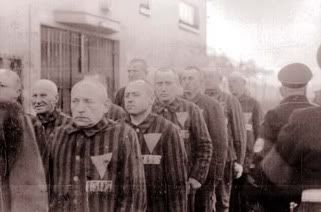The Pink Triangle - Cruel Fate or Solidarity


The Pink Triangle was used by the Nazis to signify homosexuals. Although, homosexuals were only one of the groups targeted for extermination, it is unfortunately, the group that history often excludes. The Pink Triangle defies anyone to deny history.
As most everyone knows, the pink triangle is a symbol taken directly from the Nazi concentration camps. Usually when concentration camps and Nazis are mentioned, most people tend to think of Jews and the Jewish Holocaust (for good reason). But the fact that a large number of homosexual prisoners were in those same camps is an often ignored or overlooked fact of history.
The real story behind the pink triangle begins prior to World War II. Paragraph 175, a clause in German law, prohibited homosexual relations (much like many states in the U.S. today have laws against "crimes of nature"). In 1935, during Hitler's rise to power, he extended this law to include homosexual kissing, embracing, and even having homosexual fantasies. An estimated 25,000 people were convicted under this law between 1937 and 1939 alone. They were sent to prisons and later concentration camps. Their sentence also included sterilization, most commonly in the form of castration. In 1942, Hitler extended the punishment for homosexuality to death.
Prisoners in Nazi concentration camps were labeled according to their crimes by inverted colored triangles. "Regular" criminals were denoted by a green triangle, political prisoners by red triangles and Jews by two overlapping yellow triangles in the form of the Mogen David (the Star of David, the most common Jewish symbol). Homosexual prisoners were labels with pink triangles. Gay Jews- the lowest form of prisoner- had overlapping yellow and pink triangles. This system also created a social hierarchy among the prisoners, and it has been reported that the pink triangle prisoners often received the worst workloads and were continually harassed and beaten by both guards and other prisoners.
Concentration camp prisoners were designated into groups by colored inverted triangles. Which set up a social hierarchy among prisoners. A green triangle marked the wearer as a regular criminal.; a red triangle denoted a political prisoner. Two yellow overlapping triangles forming a Star of David denotes Jewish prisoners. The Pink Triangle was for homosexuals. A yellow Star of David under a superimposed Pink Triangle represented Gay Jewish prisoners-- by the social hierarchy, the lowest of all prisoners.
Although homosexual prisoners were not shipped en mass to the Auschwitz death camps like so many of the Jewish prisoners, there were still large numbers of gay men executed there along with other non-Jewish prisoners. The real tragedy though occurred after the war. When the Allies defeated the Germany and the Nazi Regime, the political and remaining Jewish prisoners were released from the camps (the regular criminals- murderers, rapists, etc.- were not released for obvious reasons). The homosexual prisoners were never released though because Paragraph 175 remained West German law until 1969. So these innocent men watched as their fellow prisoners were set free, but remained prisoners for 24 more years.
In the 1970s, the pink triangle started to be used in conjunction with the gay liberation movement. When people, especially public figures such as law makers, were confronted with such a symbol, they risked being associated with the Nazis if he or she were to attempt to openly limit or prosecute gays. In the 1980s, when the triangle's popularity truly began to take off, ACT-UP (AIDS Coalition To Unleash Power) adopted the it as their symbol, but turned it upright to suggest an active fight rather than passive resignation. I've also been told that some people wear their triangles pointing up if they personally know somebody who has died of AIDS. In any case, the pink triangle is definitely a symbol very closely connected to oppression and the fight against it, and stands as a vow never to let another Holocaust happen again. Like the word "queer," it is a symbol of hate which has been reclaimed and now stands for pride.
When the war was finally over, many homosexuals remained prisoners in the camps until 1969 when Paragraph 175 was repealed in West Germany.
The Pink Triangle was adopted by many Gay rights groups in the 1970s. Because, it draws attention to the oppression and persecution -- then and now.
In the 80s, ACT-UP (Aids Coalition To Unleash Power) started using a Pink Triangle that pointed up, to signify an active fight back , rather than a passive resignation to fate.
Today, for many including myself, the Pink Triangle represents Pride and Solidarity...Unity.
Jase ;0)
This site needs an editor - click to learn more!

Related Articles
Editor's Picks Articles
Top Ten Articles
Previous Features
Site Map
Content copyright © 2023 by Jason P. Ruel. All rights reserved.
This content was written by Jason P. Ruel. If you wish to use this content in any manner, you need written permission. Contact
BellaOnline Administration
for details.


